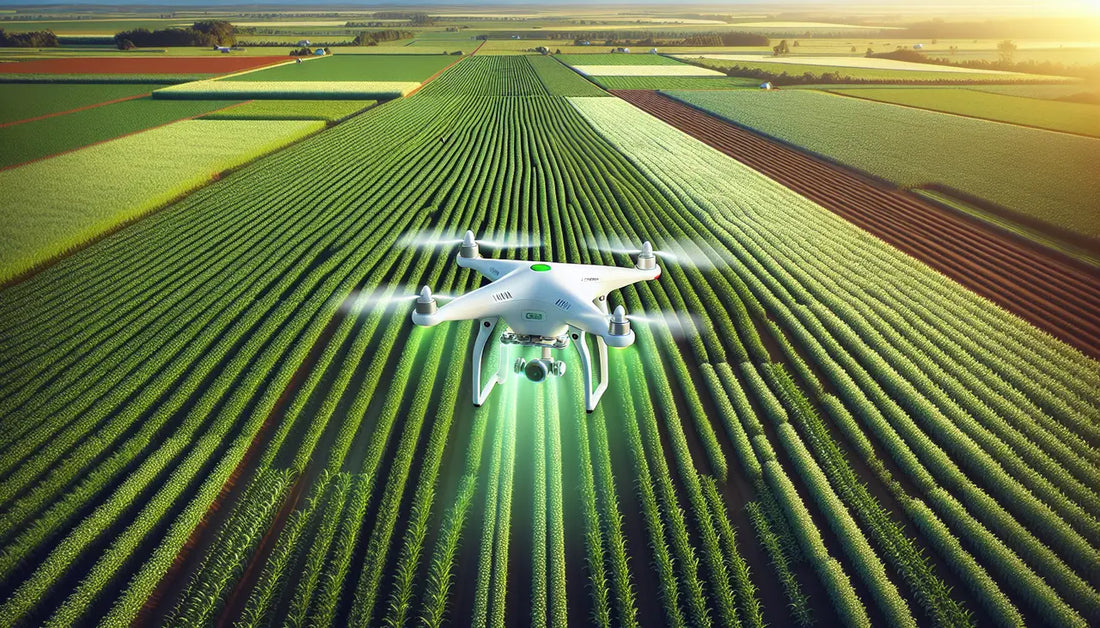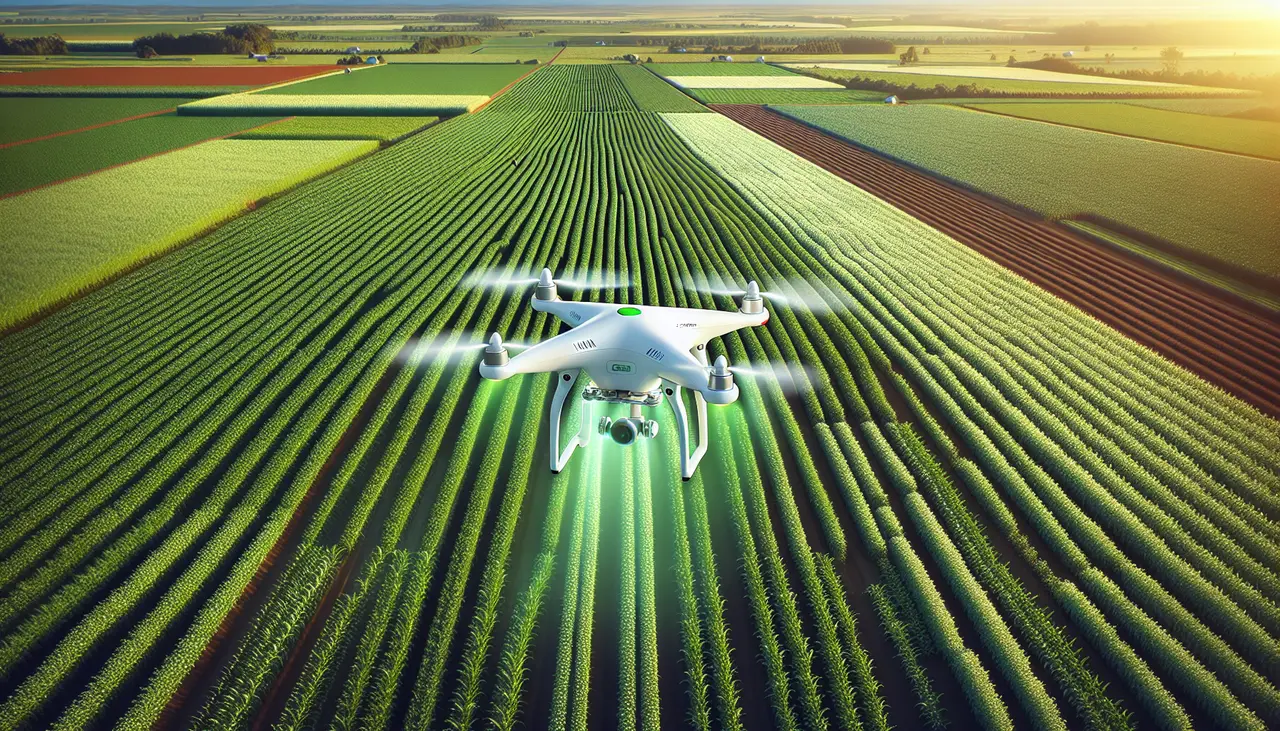
Maximizing Crop Yields with Precision Agriculture Using Drones
Share
Introduction to Precision Agriculture and Its Significance
Precision agriculture isn’t just a fancy term; it’s the future of farming. This method uses technology to make farming more accurate and controlled. The star player? Drones. Here’s why it’s a big deal. Traditional farming guesses what crops need. Precision agriculture uses data, making every drop of water and every bit of fertilizer count. This means healthier crops and bigger yields with less waste. It’s not just good for the farmer’s wallet; it’s great for the planet too. By targeting exactly what the crops need, we can cut down on unnecessary water use and reduce harmful runoff into our rivers and oceans. In a nutshell, precision agriculture, spearheaded by drone technology, marks a significant leap towards more sustainable and efficient farming practices.
The Role of Agricultural Drones in Modern Farming
Agricultural drones are changing the game in modern farming. These high-flying helpers let farmers see their fields from the sky. This bird’s-eye view is not just for show. It gives crucial information that can help grow more food using less stuff like water and fertilizers. Think of drones as the farmer’s eye in the sky. They can quickly check out large areas of land, spotting problems like pests or dry spots that the human eye might miss from the ground. This means farmers can act fast, targeting just the areas that need help rather than the whole field. It’s like being a sniper with farm care, sharp and to the point. Plus, these drones can track the growth of crops, making it easy to spot if a certain part isn’t doing as well as expected. With this info, adjustments can be made on the fly, ensuring every plant has the best shot at thriving. In sum, agricultural drones make farming smarter, not harder.
Understanding How Drones Are Revolutionizing Crop Management
Farmers now have a high-tech helper above the fields: drones. These flying marvels are shifting how we manage crops. Drones, equipped with advanced sensors and imaging capabilities, provide a bird’s-eye view of the farm, far beyond what a farmer can see from the ground. They help in mapping out the farm, analyzing soil health, and even spotting problems like pests or diseases early on. This means farmers can act swiftly to address issues, leading to healthier crops and more food production. Think of drones as your crops’ early warning system. They can detect changes in plants that signify stress from lack of water, nutrients, or disease - often before these problems are visible to the human eye. Drones allow for precision agriculture; that is, applying the exact amount of water, fertilizers, or pesticides exactly where they’re needed. This not only boosts crop yields but also reduces waste and environmental impact. So, in a nutshell, drones are revolutionizing crop management by making farming more efficient, sustainable, and productive.
Key Benefits of Using Agricultural Drones for Crop Monitoring
Drones are changing farming. They let farmers see their fields from the sky and get details that can’t be seen from the ground. This means farmers can make better decisions, save time, and cut costs. Here’s how drones help in crop monitoring: First, drones can quickly check large areas, spotting problems like pests or diseases before they spread. This early detection means farmers can act fast, protecting crops better. Second, drones gather data on plant health, moisture levels, and more. This info helps farmers understand their fields in detail, so they can water, fertilize, and take actions more effectively. Third, using drones is eco-friendly. They help reduce water usage, limit chemical use by targeting exactly where treatment is needed, and decrease the need for heavy machinery in the fields. Lastly, drones save time. What used to take hours or days, walking or driving through fields, now takes minutes. This efficiency boost means farmers can focus more on other important work, making their farms more productive. So, drones aren’t just cool gadgets; they’re powerful tools that make farming smarter.
Types of Drones Used in Precision Agriculture
In precision agriculture, not all drones are created equal. There are mainly two types that stand out: fixed-wing drones and multi-rotor drones. Fixed-wing drones resemble traditional airplanes. They can cover vast areas on a single flight, making them perfect for large farms. On the downside, they require a space to take off and land, and they’re generally pricier. Multi-rotor drones, such as quadcopters, are more common. They’re excellent for smaller areas and can hover in one spot, which is great for taking detailed images of crops. However, they don’t cover as much ground as fixed-wing drones and have shorter flight times. Choosing between them depends on your farm’s size and the precision you need.
Step-by-Step Guide: Implementing Drones in Crop Management
First up, pick the right drone with a camera and sensors that suit your fields. We’re talking near-infrared cameras for health checks on your crops. Once you’ve got your drone, learn the ropes. This means knowing how to operate it and understanding the data it gives you. Next, map out your land. Use the drone to take a bird’s-eye view and mark out different zones. This helps in knowing where to focus. After mapping, regularly fly your drone over the fields. This isn’t just a one-time thing. Keep track of crop health, growth, and spot any issues early on. The data you collect? Use it. Analyze it to make decisions on watering, pesticide use, and planting strategies. Stay on top of this tech. Drone technology moves fast. Keep learning and adapting to get the most out of your crops. Simple steps, but following them can seriously boost what you get from your land.
Optimizing Water Usage and Irrigation with Drone Technology
Drones are changing the game in agriculture, especially when it comes to water management. Here’s the deal: using drones, farmers can see exactly where water is needed and where it’s not. This means no more guessing or wasting water. We’re talking about precision irrigation, where drones equipped with special sensors fly over crops. These sensors check soil moisture levels and send the info back in real time. So, what happens? Farmers adjust their irrigation systems based on this data. The result? Water is used wisely, crops get exactly what they need, and nothing goes to waste. Plus, this smart use of water leads to healthier crops and bigger yields. In short, drones make sure every drop of water counts, which is a win-win for both farmers and the environment.
Precision Pest and Disease Control Using Agricultural Drones
Drones are changing the game in farming, especially when tackling pests and diseases. Picture this: a drone flying over your crops, equipped with high-definition cameras and sensors. It scans every inch of your fields, spotting trouble spots with pests or disease that the human eye might miss. Instead of spraying your whole field with pesticides, drones let you target just the bad guys. This is precision agriculture. You save money on chemicals, protect your crops more effectively, and even do a favor for the environment by reducing pesticide use. Plus, catching diseases early means you can stop them from spreading, keeping your crops healthy and boosting your yields. With drones, you’re not just farming smarter; you’re farming for the future.
Analyzing Drone Data for Improved Crop Yield Decisions
Drones collect loads of data. Think pictures, temperature readings, and soil conditions. Farmers use this gold mine to make better choices. Here’s how it goes down: they look at images from the drone to see which parts of the field are dry or need more nutrients. Temperature and humidity info helps decide the best planting times. Soil analysis points out exactly where to add fertilizer or water. This isn’t about guessing; it’s smart farming. By analyzing this data, farmers can increase their crop yields without wasting resources. It’s about growing more with less, optimizing every drop of water and every ounce of fertilizer. Precision agriculture, powered by drone data, changes the game by making every decision count.
Future Trends: The Evolving Landscape of Agricultural Drones and Farming Efficiency
Drones are changing farming, folks. They’re leading us into a future where farms will run smarter, not harder. This means farmers can see which parts of their fields need more water, fertilizer, or pest control, just by flying a drone over them. It’s like having eyes in the sky. Imagine being able to spot a problem with your crops before it spreads, saving time, resources, and, most importantly, your hard-earned crop.
But wait, it gets even better. The tech behind these farming wonders is zooming ahead. We’re not just talking about taking pretty pictures from the air. These drones are getting decked out with sophisticated sensors that can tell you about the health of your plants by looking at them in wavelengths of light we can’t even see with our naked eyes.
And costs? They’re coming down. As more farmers start using drones, the tech gets cheaper, making it accessible even to the smaller guys out there. Plus, with AI stepping into the mix, these drones can analyze the data on the fly, giving you real-time advice on how to boost your yields.
So, here’s the deal: the future of farming with drones is all about being precise. It’s about using less to grow more. It’s about knowing exactly what your crops need and when they need it. And this isn’t just some fancy dream. It’s happening right now, and it’s going to make farming more efficient, sustainable, and, yes, more profitable. Keep an eye on this trend, because it’s only going up from here.

